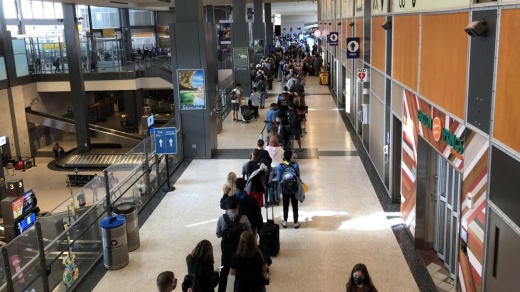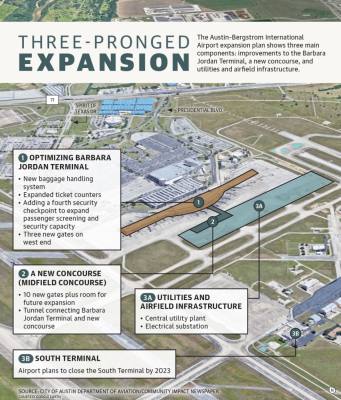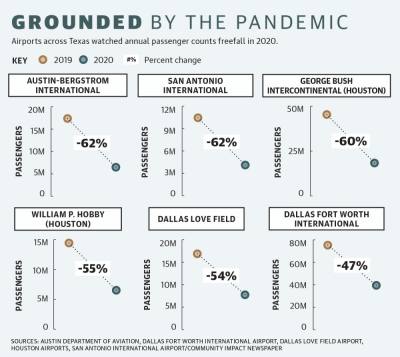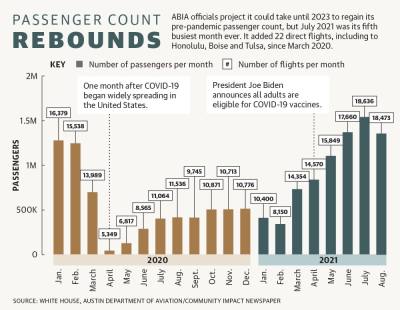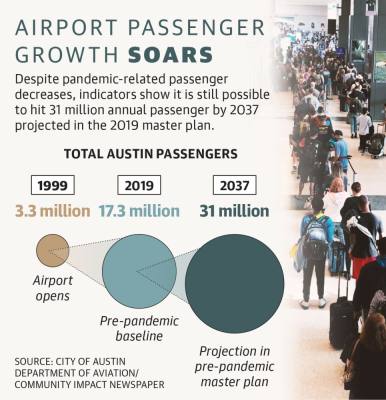The total number of passengers reached its low point in April 2020 at 47,781 passengers, a 97% decrease compared to April 2019. ABIA was hardly alone as the entire airline industry grappled with a significant downturn in passengers.
However, ABIA did prove unique in how fast it has seemingly recovered, according to data from the city of Austin Aviation Department and the U.S. Bureau of Transportation Statistics. The most recent federal data available shows passenger traffic 20% lower in June 2021 than the same month in 2019, compared to a 15% drop at ABIA.
In July, ABIA reported it had its fifth-busiest month in history with more than 1.5 million passengers. As traffic increased in July, ABIA made another splash, announcing a massive expansion plan called the Airport Expansion and Development Program as part of its rollout of the 2019 master plan.
ABIA CEO Jacqueline Yaft said Austin’s population growth and airline demand to add flights indicated the timing for expansion was right.
“In this stage today, we are recovering much faster than what our forecast has called for,” Yaft said. “We are getting requests by the airlines for growth and more capacity and room for them to add more flights, so all indications are showing that we need to implement our master plan for 2040 and get in this expansion program as fast as possible.”
Airport officials view the recently announced expansion program as an initial phase in attaining the goals laid out in its 2040 master plan. The plan forecasts the airport will reach 31 million passengers and need 64 gates by 2037, nearly double the record-breaking 17 million passengers in 2019 and current 34 gates plus the three South Terminal gates.
In 2019, nine new gates opened as part of a $350 million expansion on the eastern wing. Four of those gates are designed to accommodate international flights. Airport officials also continued to plan for a new baggage-handling system and expanded security capacity during the pandemic.
The expansion program aims to make large-scale renovations to the main terminal, known as the Barbara Jordan Terminal; add a new concourse that could house 10 or more gates; and close the recently opened South Terminal by 2023.
“We did not take our foot off the gas during COVID[-19] because some of these projects we know we needed them to continue working,” Yaft said.
She added the airport has experienced remarkable growth in recent years with boardings growing by almost 10% between 2018 and 2019 compared to around 4% for the industry during the same period, according to Federal Aviation Administration data.
The expansion program
Yaft said much of the proposed program is conceptual, as a principal architect will be hired in February to solidify designs and timelines. However, some of the $325 million Barbara Jordan Terminal optimizations are already underway. Funding for the expansion will come from airport revenues and cash reserves as well as FAA grants, according to an ABIA press release.
The highest-priced item in the Barbara Jordan Terminal optimizations is the $125 million baggage-handling system, which could be completed as soon as late 2023.
The second-largest element includes $100 million to extend the upper floor over the baggage claim, which would add ticketing and security space.
While much of the expanded gate capacity will come from the new concourse, the airport also plans to spend $70 million on gate capacity in its west wing and $14 million on interim new gate capacity in its east wing. The expansion on the west will add three permanent gates, and the expansion on the airport’s east involves busing operations that will temporarily take passengers to board planes on the tarmac, airport spokesperson Sam Haynes said.
The budget details $15 million for supporting infrastructure and $1.5 million to add a security checkpoint and improve the processing speed of the Transportation Security Administration’s machinery.
Cost estimates for the new concourse, called the Midfield Concourse, are to be determined. It will connect to the Barbara Jordan Terminal by a tunnel and have capacity for 10 or more gates. The estimated timeline for the concourse implementation is around seven years, Haynes said.
The third phase of the program includes infrastructure and utilities enhancements, including a new central utility plant and electrical substation.
Eugene Sepulveda, chair of Austin’s Aviation Advisory Commission, said ABIA, which has gained 22 new nonstop routes since March 2020, needs a sense of urgency.
“Even though we had done the nine-gate expansion and opened up in 2019, which took us from about 11 million enplanements per year to 15 [million], we were already behind,” Sepulveda said. “Greater than the growth of population is the growth in commerce and the economy, which I say that to signal that air travel was growing at an even greater clip than population.”
Airport planning experts agree with ABIA’s decision to move forward with expansion. Max Hirsh, managing director of the Airport City Academy, a group that specializes in airport real estate projects, said that smart airports are forging ahead with improving their facilities.
“[Airports] understand that these kinds of projects deliver benefits for decades and are keeping a long-term perspective. They also see COVID as a once-in-a-lifetime opportunity to complete these projects quickly and cheaply,” Hirsh said in an email.
While ABIA is approaching prepandemic levels, Hirsh said reduced passenger traffic creates significant advantages for airports to build efficiently because they can move forward with projects without needing to work around regular flight operations.
South Terminal standoff
Officials with the city, which owns the airport, have also said they will close the South Terminal, which opened in 2016 and caters to low-cost carriers.
The South Terminal is operated by Lonestar Airport Holdings, which signed a 40-year lease in May 2016 with the city to manage the facility. Community Impact Newspaper obtained a copy of the lease through a public information request, which offers some details around Lonestar Airport Holdings’ rights as a tenant.
The lease states that so long as the tenant pays rent and observes the lease agreements, it “may peaceably and quietly have, hold, occupy, use and enjoy the premises during the term and may exercise all of its rights hereunder, without ejection or interference by [the] owner.”
Lonestar Airport Holdings CEO Jeff Pearse said the timing is not right for the company to exit the lease.
“We have no intention of sacrificing any of our rights under the lease,” Pearse said. “There’s too much riding on it.”
Yaft said the airport is equipped to handle Allegiant and Frontier, which fly out of the South Terminal, moving to the main terminal.
Pearse said that he does not understand how that is possible.
“They don’t have enough gates as it is, and to reduce the number of gates at the airport by three, as demand is increasing, again—surprising,” Pearse said.
Meanwhile, Allegiant has continued to expand its operations out of the South Terminal. Pearse said beginning Nov. 18, it plans to almost triple its Austin operations to 45 flights per week on average.
With the expectation of a legal battle, the city largely declined to comment on the South Terminal. In a statement it said: “Lonestar recently notified the city of Austin that it is not interested in participating in a structured negotiation process related to this matter. Due to anticipated litigation, we cannot provide additional information at this time.”
Pearse said in an email that he remains open to working with the city to help expand the airport, including through “operations and management of a new terminal, providing much needed financing and capital for the expansion or the relocation and expansion of an ultra-low cost carrier terminal that would support domestic and international flights.”
Airport and mobility
The proposed expansion coincides with a handful of major mobility projects in Austin with none larger than Project Connect. The designs revealed during the summer for the $7.1 billion project show the MetroRail Blue Line running from downtown to the airport.
Assistant City Manager Gina Fiandaca oversees mobility, which includes the airport, and views that investment as critical to the airport’s growth.
“Transit plays a big part of how people get around, and it’s foundational to how people are getting to your city center from your airport,” she said. “Building out the Blue Line with that direct connection to the airport is really key. We know that as the city grows, our roadway system can’t keep growing.”
Fiandaca said as the city continues to grow, the airport is likely to follow suit.
“When’s the best time to plant a tree? Well, 20 years ago was the best time, and what’s the second best time? Right now,” Fiandaca said.




